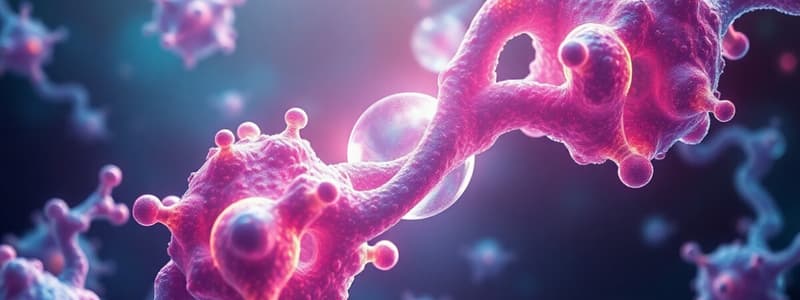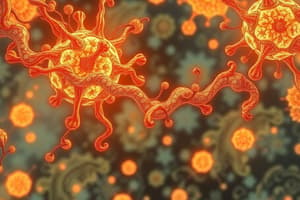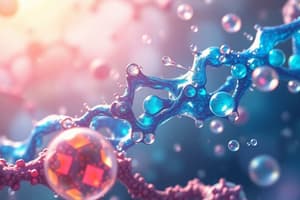Podcast
Questions and Answers
What type of metabolic disorder is Medium acyl-coA dehydrogenase deficiency (MCADD)?
What type of metabolic disorder is Medium acyl-coA dehydrogenase deficiency (MCADD)?
- Enzyme activation issue
- Increased enzyme activity
- Drug metabolism disorder
- Inborn error of metabolism (correct)
Which enzyme is specifically related to the metabolism of xanthine?
Which enzyme is specifically related to the metabolism of xanthine?
- Xanthine oxidase (correct)
- Hypoxanthine oxidase
- Uricase
- Acyl-coA dehydrogenase
What is one of the roles of enzymes in drug metabolism?
What is one of the roles of enzymes in drug metabolism?
- Regulation of gene expression
- Converting substrates into non-toxic products only
- Activation of pro-drugs (correct)
- Decreasing enzyme activity
Which factor is NOT mentioned as influencing enzyme function?
Which factor is NOT mentioned as influencing enzyme function?
What role do coenzymes play in enzymatic activity?
What role do coenzymes play in enzymatic activity?
How does temperature affect enzyme function?
How does temperature affect enzyme function?
Which type of enzyme is responsible for bond cleavage via reaction with water?
Which type of enzyme is responsible for bond cleavage via reaction with water?
How do cofactors influence enzyme activity?
How do cofactors influence enzyme activity?
What is the primary function of ligases in enzymatic reactions?
What is the primary function of ligases in enzymatic reactions?
What defines the function of transferases?
What defines the function of transferases?
Which statement best describes oxidoreductases?
Which statement best describes oxidoreductases?
What kind of reactions do lyases catalyze?
What kind of reactions do lyases catalyze?
Which factor might inhibit enzyme activity?
Which factor might inhibit enzyme activity?
What is a primary characteristic of isomerases?
What is a primary characteristic of isomerases?
How do metal ions function as cofactors?
How do metal ions function as cofactors?
Which of the following types of enzymes is mainly involved in the transfer of functional groups?
Which of the following types of enzymes is mainly involved in the transfer of functional groups?
What distinguishes coenzymes from cofactors in enzymatic reactions?
What distinguishes coenzymes from cofactors in enzymatic reactions?
What role do oxidoreductases primarily play in biochemical reactions?
What role do oxidoreductases primarily play in biochemical reactions?
Which enzyme type is responsible for the covalent linkage of two substrates?
Which enzyme type is responsible for the covalent linkage of two substrates?
How do metal ions serve as cofactors in enzymatic reactions?
How do metal ions serve as cofactors in enzymatic reactions?
Which of the following is a consequence of Medium acyl-coA dehydrogenase deficiency (MCADD)?
Which of the following is a consequence of Medium acyl-coA dehydrogenase deficiency (MCADD)?
What is a potential therapeutic application of enzyme modulation in medicine?
What is a potential therapeutic application of enzyme modulation in medicine?
What is the role of xanthine oxidase in the metabolic pathway leading to uric acid production?
What is the role of xanthine oxidase in the metabolic pathway leading to uric acid production?
Which statement accurately describes the role of enzymes in drug action?
Which statement accurately describes the role of enzymes in drug action?
Which factor likely enhances enzyme activity under normal physiological conditions?
Which factor likely enhances enzyme activity under normal physiological conditions?
Flashcards are hidden until you start studying
Study Notes
What are Enzymes?
- Enzymes are biological catalysts that speed up the rate of chemical reactions in living organisms.
- Most enzymes are proteins, built from amino acids.
Why are enzymes important?
- They facilitate essential metabolic processes within the body
- Promote biochemical reactions that would be impossible without them.
- Essential for life
How do enzymes work?
- Enzymes decrease the activation energy needed for a reaction to occur.
- They bind to substrates at the active site to form an enzyme-substrate complex.
- This interaction promotes the formation of a transition state.
- The product is released and the enzyme is free to catalyze other reactions.
Types of Enzymes
- Oxidoreductases: Catalyze oxidation-reduction reactions involving the transfer of electrons. These reactions often involve the transfer of reducing equivalents.
- Isomerases: Catalyze isomerization reactions, where the structure of a molecule is rearranged.
- Transferases: Catalyze the transfer of functional groups, such as methyl, phosphoryl, sulfate, or sugar groups between molecules.
- Hydrolases: Catalyze the cleavage of chemical bonds by the addition of water.
- Lyases: Catalyze the addition or elimination of groups to or from double bonds. These enzymes can cleave C-O, C-S, and C-C bonds.
- Ligases: Catalyze the formation of new covalent bonds between two molecules. These enzymes use ATP as a source of energy and are often involved in joining DNA bases or attaching ubiquitin to proteins.
Coenzymes and Cofactors
- Coenzymes: Organic molecules, typically derived from vitamins, that act as carriers of electrons or functional groups during enzymatic reactions.
- Cofactors: Non-protein molecules, often inorganic ions, that bind to enzymes and facilitate enzymatic activity.
Regulation of Enzyme Activity
- Substrate Concentration: Increasing substrate concentration increases enzyme activity to a point, after which the enzyme becomes saturated.
- Inhibitors: Molecules that bind to enzymes and reduce their activity.
- Gene Expression: Regulating the amount of enzyme produced can control enzyme activity.
- Proenzyme Activation: Proenzymes are inactive precursors that require modification (e.g., cleavage) to become active enzymes.
- Protein Stability: Protein degradation can remove enzymes and regulate activity.
- Localization: Moving enzymes to different cellular compartments can affect their activity.
Factors Affecting Enzyme Function
- Temperature: Optimal temperature provides maximum activity, while extreme temperatures can denature the enzyme.
- pH: Each enzyme has a specific pH range for optimal activity.
- Substrate Concentration: Increased concentration leads to higher enzyme activity until saturation.
Enzymes in Medicine - Metabolic Diseases
- Medium Acyl-CoA Dehydrogenase Deficiency (MCADD):
- An inborn error of metabolism.
- Results from a defect in the beta-oxidation of fatty acids, essential for energy production.
- Specifically, MCADD affects enzymes responsible for oxidizing fatty acids with 4 to 12 carbons.
Enzymes in Medicine - Drug Metabolism
- Prodrugs: Inactive substances that are activated by enzymes in the body to become active medications. This allows for targeted drug delivery and avoids unwanted systemic effects.
- Toxicity Modulation: Enzymes can alter drug toxicity, sometimes by converting a toxic substance into a less toxic one.
- Drug Action Modification: Enzymes can influence the duration and effectiveness of a drug by speeding up its breakdown or metabolism.
Enzymes in Medicine - Drug Targets
- Gout: Caused by high levels of uric acid in the blood due to a buildup of purine metabolism products.
- Xanthine Oxidase: The enzyme targeted in gout treatment.
- Allopurinol: A drug that inhibits xanthine oxidase, preventing uric acid overproduction.
- Hypoxanthine: A substrate for xanthine oxidase, converted to xanthine and ultimately to uric acid.
What are enzymes?
- Enzymes are biological catalysts which accelerate the rate of biochemical reactions.
- They are usually proteins but there are also some that are made of RNA.
- They are highly specific.
- Enzymes are not consumed during the reaction – they simply catalyse the reaction.
Why are enzymes important?
- They are essential for almost all biological processes.
- They are involved in metabolism, digestion, DNA replication, and many other cellular processes.
How do enzymes work?
- They work by providing an alternative reaction pathway with a lower activation energy.
- This allows the reaction to proceed at a faster rate.
Types of enzymes
- Oxidoreductases catalyse oxidation-reduction reactions.
- Examples include dehydrogenases
- Isomerases catalyse isomerisation or rearrangement reactions.
- Example is glucose to fructose.
- Transferases catalyse transfer of functional groups.
- Examples include methyl, phosphoryl, sulfate, sugars.
- Hydrolases catalyse bond cleavage via reaction with water.
- Lyases catalyse addition and elimination reactions.
- They cleave C-O, C-S and C-C bonds.
- Ligases catalyse covalent linkage of two substrates together.
- Examples include DNA bases, Ubiquitin onto peptide side chains.
Coenzymes and cofactors
- Coenzymes are organic molecules required for an enzyme.
- They are often derived from vitamins.
- They act as carriers of electrons or chemical groups.
- Examples are NADPH, AcoA
- Cofactors are non-protein molecules required for an enzyme.
- They change the structure of an active site in the enzyme.
- They facilitate enzymatic activity.
- Examples are metal ions.
- Both coenzymes and cofactors facilitate enzymatic activity.
Regulation of activity
- Enzymes can be regulated by the amount of substrate available.
- Enzymes can be regulated by the availability of inhibitors.
- Inhibitors compete with substrates for active sites.
How else can we regulate activity?
- Gene expression
- Pro-enzyme activation
- Protein stability
- Localisation
Factors affecting enzyme function
- Temperature
- Enzymes have an optimal temperature at which they function best.
- Increasing temperature beyond the optimum will result in denaturation of the enzyme.
- pH
- Enzymes have an optimal pH at which they function best.
- Changes in pH can alter the shape of the enzyme and affect its activity.
- Substrate concentration
- Increasing substrate concentration will increase enzymatic activity until saturation is reached.
- Product concentration
- Product accumulation can inhibit enzymatic activity. This is called product inhibition.
Enzymes in medicine – metabolic diseases
- Medium Acyl-CoA Dehydrogenase Deficiency (MCADD) is an inborn error of metabolism.
- MCADD is caused by a defect in the beta-oxidation of fatty acids.
- It affects enzymes reacting with different length chains.
- It results in reduced/lost activity of those with chain length 4-12 carbon long.
Enzymes in medicine – drug metabolism
- Enzymes can activate the pro-drug.
- An example is ICT2588.
- Enzymes can modulate the toxicity of a drug.
- Enzymes can modulate the action of a drug.
Enzymes in medicine – drug targets
- Gout is an example of a disease where enzymes can be used as drug targets.
- Xanthine oxidase is an important enzyme involved in purine metabolism.
- Xanthine oxidase catalyzes the conversion of hypoxanthine to xanthine and then to uric acid.
- Drugs that inhibit xanthine oxidase can be used to treat gout.
Studying That Suits You
Use AI to generate personalized quizzes and flashcards to suit your learning preferences.





